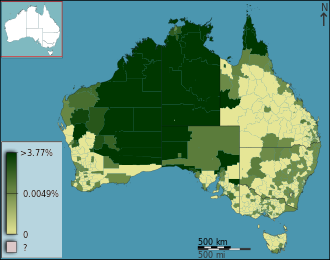

The Indigenous languages of Australia number in the hundreds, the precise number being quite uncertain, although there is a range of estimates from a minimum of around 250[1] (using the technical definition of 'language' as non-mutually intelligible varieties) up to possibly 363.[2] The Indigenous languages of Australia comprise numerous language families and isolates, perhaps as many as 13, spoken by the Indigenous peoples of mainland Australia and a few nearby islands.[3] The relationships between the language families are not clear at present although there are proposals to link some into larger groupings. Despite this uncertainty, the Indigenous Australian languages are collectively covered by the technical term "Australian languages",[4] or the "Australian family".[a]
The term can include both Tasmanian languages and the Western Torres Strait language,[6] but the genetic relationship to the mainland Australian languages of the former is unknown,[7] while the latter is Pama–Nyungan, though it shares features with the neighbouring Papuan, Eastern Trans-Fly languages, in particular Meriam Mir of the Torres Strait Islands, as well as the Papuan Tip Austronesian languages.[8] Most Australian languages belong to the widespread Pama–Nyungan family, while the remainder are classified as "non-Pama–Nyungan", which is a term of convenience that does not imply a genealogical relationship.
In the late 18th century there were more than 250 distinct First Nations Peoples social groupings and a similar number of languages or varieties.[6] The status and knowledge of Aboriginal languages today varies greatly. Many languages became extinct with settlement as the encroachment of colonial society broke up Indigenous cultures. For some of these languages, few records exist for vocabulary and grammar. At the start of the 21st century, fewer than 150 Aboriginal languages remained in daily use,[9] with the majority being highly endangered. In 2020, 90 per cent of the barely more than 100 languages still spoken are considered endangered.[10] Thirteen languages are still being transmitted to children.[11] The surviving languages are located in the most isolated areas. Of the five least endangered Western Australian Aboriginal languages, four belong to the Western Desert grouping of the Central and Great Victoria Desert.
Yolŋu languages from north-east Arnhem Land are also currently learned by children. Bilingual education is being used successfully in some communities. Seven of the most widely spoken Australian languages, such as Warlpiri, Murrinh-patha and Tiwi, retain between 1,000 and 3,000 speakers.[12] Some Indigenous communities and linguists show support for learning programmes either for language revival proper or for only "post-vernacular maintenance" (Indigenous communities having the opportunity to learn some words and concepts related to the lost language).[13]
- ^ Dixon 2002, pp. 2.
- ^ Bowern 2011.
- ^ Evans 2003, p. 2.
- ^ Dixon 2011, pp. 253–254.
- ^ Dixon 1980, p. 3.
- ^ a b Walsh 1991, p. 27.
- ^ Bowern 2012, p. 4593.
- ^ Mitchell 2015.
- ^ Dalby 2015, p. 43.
- ^ Morse, Dana (13 November 2020). "The next generation is bringing Australia's ancient languages into the future". ABC News. Australian Broadcasting Corporation. Archived from the original on 13 November 2020. Retrieved 13 November 2020.
- ^ Goldsworthy 2014.
- ^ UNESCO atlas (online)
- ^ Zuckermann 2009.
Cite error: There are <ref group=lower-alpha> tags or {{efn}} templates on this page, but the references will not show without a {{reflist|group=lower-alpha}} template or {{notelist}} template (see the help page).